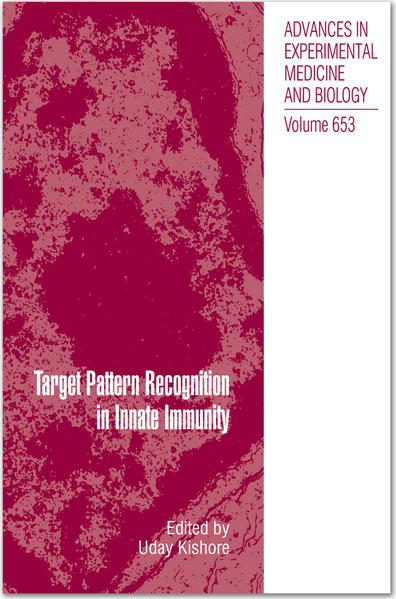
ISBN: 9781441909008
Target pattern recognition in innate immunity is responsible for the immediate, usually protective, responses shown against invading microorganisms, and it is the principal feature of sel… Mehr…
| Springer.com Nr. 978-1-4419-0900-8. Versandkosten:Worldwide free shipping, , zzgl. Versandkosten. (EUR 0.00) Details... |

2009, ISBN: 1441909001
Neubindung, Buchschnitt leicht verkürzt 5603587/12. Target Pattern Recognition in Innate Immunity. immunity,proteins,interferon,pattern,tuberculosis,autoimmunity,diseases,protozoa,bacteri… Mehr…
| ebay.de buchpark 98.9, Zahlungsarten: Paypal, APPLE_PAY, Google Pay, Visa, Mastercard, American Express, Priority Listing. Versandkosten:Versandkostenfrei, Versand zum Fixpreis, [SHT: Standardversand], 14*** Trebbin, [TO: Deutschland, Großbritannien, Frankreich, Italien, Spanien, Österreich, Polen, Schweiz, Belgien] (EUR 0.00) Details... |

2009, ISBN: 1441909001
2009 Gebundene Ausgabe Immunsystem - Immunologie - Immun - Autoimmunität, Immunologie, Tuberculosis; Autobacteria; Cytokine; diseases; infection; Innateimmunity; interferon; Macrophages… Mehr…
| Achtung-Buecher.de MARZIES.de Buch- und Medienhandel, 14621 Schönwalde-Glien Versandkosten:Versandkostenfrei innerhalb der BRD. (EUR 0.00) Details... |

2009, ISBN: 1441909001
[EAN: 9781441909008], Gebraucht, guter Zustand, [SC: 0.0], [PU: Springer US], IMMUNITY,PROTEINS,INTERFERON,PATTERN,TUBERCULOSIS,AUTOIMMUNITY,DISEASES,PROTOZOA,BACTERIA,INNATE IMMUNITY,PAR… Mehr…
| ZVAB.com Buchpark, Trebbin, Germany [83435977] [Rating: 5 (von 5)] NOT NEW BOOK. Versandkosten:Versandkostenfrei. (EUR 0.00) Details... |

2009, ISBN: 9781441909008
[PU: Springer US], Neubindung, Buchschnitt leicht verkürzt 5603587/12, DE, [SC: 0.00], gebraucht; sehr gut, gewerbliches Angebot, 2009, Banküberweisung, PayPal, Klarna-Sofortüberweisung, … Mehr…
| booklooker.de |

ISBN: 9781441909008
Target pattern recognition in innate immunity is responsible for the immediate, usually protective, responses shown against invading microorganisms, and it is the principal feature of sel… Mehr…

2009, ISBN: 1441909001
Neubindung, Buchschnitt leicht verkürzt 5603587/12. Target Pattern Recognition in Innate Immunity. immunity,proteins,interferon,pattern,tuberculosis,autoimmunity,diseases,protozoa,bacteri… Mehr…
2009
ISBN: 1441909001
2009 Gebundene Ausgabe Immunsystem - Immunologie - Immun - Autoimmunität, Immunologie, Tuberculosis; Autobacteria; Cytokine; diseases; infection; Innateimmunity; interferon; Macrophages… Mehr…
2009, ISBN: 1441909001
[EAN: 9781441909008], Gebraucht, guter Zustand, [SC: 0.0], [PU: Springer US], IMMUNITY,PROTEINS,INTERFERON,PATTERN,TUBERCULOSIS,AUTOIMMUNITY,DISEASES,PROTOZOA,BACTERIA,INNATE IMMUNITY,PAR… Mehr…

2009, ISBN: 9781441909008
[PU: Springer US], Neubindung, Buchschnitt leicht verkürzt 5603587/12, DE, [SC: 0.00], gebraucht; sehr gut, gewerbliches Angebot, 2009, Banküberweisung, PayPal, Klarna-Sofortüberweisung, … Mehr…
Bibliographische Daten des bestpassenden Buches
| Autor: | |
| Titel: | |
| ISBN-Nummer: |
Detailangaben zum Buch - Target Pattern Recognition in Innate Immunity
EAN (ISBN-13): 9781441909008
ISBN (ISBN-10): 1441909001
Gebundene Ausgabe
Taschenbuch
Erscheinungsjahr: 2009
Herausgeber: Springer New York
222 Seiten
Gewicht: 0,528 kg
Sprache: eng/Englisch
Buch in der Datenbank seit 2008-12-31T11:35:46+01:00 (Zurich)
Detailseite zuletzt geändert am 2024-01-20T15:14:27+01:00 (Zurich)
ISBN/EAN: 1441909001
ISBN - alternative Schreibweisen:
1-4419-0900-1, 978-1-4419-0900-8
Alternative Schreibweisen und verwandte Suchbegriffe:
Autor des Buches: alexander, kishore
Titel des Buches: target, pattern recognition, the pattern, 653
Daten vom Verlag:
Autor/in: Uday Kishore
Titel: Advances in Experimental Medicine and Biology; Target Pattern Recognition in Innate Immunity
Verlag: Springer; Springer US
202 Seiten
Erscheinungsjahr: 2009-07-09
New York; NY; US
Sprache: Englisch
160,49 € (DE)
164,99 € (AT)
177,00 CHF (CH)
Available
XX, 202 p.
BB; Hardcover, Softcover / Medizin/Nichtklinische Fächer; Medizinische Forschung; Verstehen; autoimmunity; bacteria; cytokine; diseases; immunity; infection; innate immunity; interferon; macrophages; parasite; pattern; pattern recognition; proteins; protozoa; tuberculosis; Biomedical Research; Immunology; Immunologie; EA; BC
Macrophage Pattern Recognition Receptors in Immunity, Homeostasis and Self Tolerance.- Pattern Recognition by Toll-like Receptors.- NOD-Like Receptors—Pivotal Guardians of the Immunological Integrity of Barrier Organs.- Toll-like Receptors and NOD-Like Receptors: Domain Architecture and Cellular Signalling.- Humoral Pattern Recognition Molecules: Mannan-Binding Lectin and Ficolins.- Lung Surfactant Proteins A and D as Pattern Recognition Proteins.- Pattern Recognition by Pentraxins.- Target Pattern Recognition by Complement Proteins of the Classical and Alternative Pathways.- Pattern Recognition in Phagocytic Clearance of Altered Self.- Structural Basis of Pattern Recognition by Innate Immune Molecules.- Lessons from the Fly: Pattern Recognition in Drosophila melanogaster.- Immune Recognition of Plasmodium-Infected Erythrocytes.- Innate Immune Recognition in Tuberculosis Infection.Weitere, andere Bücher, die diesem Buch sehr ähnlich sein könnten:
Neuestes ähnliches Buch:
9781461417095 Target Pattern Recognition in Innate Immunity Uday Kishore Editor (Herausgegeben:Kishore, Uday)
< zum Archiv...



